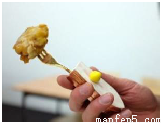题目内容
If you put all the books you own on the street outside your house, you might expect them to disappear immediately. But one man, Hernando Guanlao in Manila, tried it and found that his collections grew.
He’s a lovely man in his early 60s, with one ever-lasting love—books. They’re his pride and joy, because, whether he likes it or not, they seem to be taking over his house. Guanlao has set up a “library” outside his home in central Manila. Readers can take as many books as they want, for as long as they want. As Guanlao says, “The only rule is that there are no rules.”
You might consider it would end very quickly. But in fact, in the 12 years he’s been running his library. He’s found that his collection has grown rather than become smaller, as more and more people help the activity. “It seems to me that the books are speaking to me,” he says with a smile, “The books are telling me they want to be read.”
Guanlao started his library in 2000, shortly after the death of his parents. He was looking for something to honor their memory, and that was when he hit upon the idea of promoting the reading habit passed on to him from his parents. So he put the books outside the door of his house to see if anyone wanted to borrow them. They did, and they brought the books back with others to add to the collection. The library was born. The library is not advertised, but somehow, every day, a steady stream of people find their way there.
To help the poorest communities in Manila, Guanlao doesn’t wait for them to find him on his “book bike”. He wants to set up a “book boat”, traveling around the islands of Sulu and Basilan. As we sat outside Hernando Guanlao’s house in the midday sun, watching people look through his collection, he thought it was worth spending all his time.
1.The first paragraph shows that Guanlao ______.
A. was a successful man
B. worked very hard
C. loved books very much
D. put all his books in the open air
2.According to the passage, readers in Guanlao’s library ______.
A. can’t keep books very long
B. need to have a library card
C. can be free to read there
D. must help increase the collection
3.What was beyond people’s expectation after the library was set up?
A. The library took over his house.
B. The library was Guanlao’s life center.
C. The library lasted a long time.
D. The library needed help from more people.
4.What caused Guanlao to have the idea of setting up a library?
A. His good reading habit.
B. The death of his parents.
C. The joy of reading books.
D. Nothing to do in his daily life.
5.What is the last paragraph mainly talking about?
A. Guanlao’s traveling around.
B. Guanlao’s daily activities.
C. Guanlao’s poor communities.
D. Guanlao’s efforts for his library.
 精英口算卡系列答案
精英口算卡系列答案

